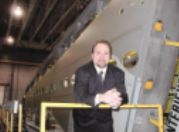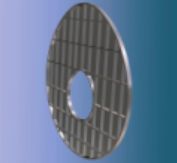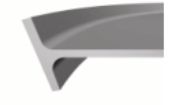E-Archive
Articles
in Vol. 3 - November Issue - Year 2002
The Growth Factor

Author: Guy Levasseur, Director Business Development

Diagram of a shot impacting aluminium

Diagram of a shot impacting a metallic substrate

Example of bulkhead section

Example of spar with tight tolerance feature

Examples of bulkhead flanges

Example of a growth affected bulkhead flange

Diagram of a shot dimple with ridges
When shot peening or peen forming is used in the manufacturing of a component, a phenomenon unfamiliar to many people, called growth, comes in to play. No matter how much or how little shot peening is applied, growth will always transform the part’s geometry.
Growth is created when a shot impacts with the surface of a component onto which shot peening and / or peen forming is applied. The resulting energy transfer from the spherical ball to the aluminum, called kinetic energy, creates a dimple and imparts a surface plastic deformation, which generates a material displacement in all direction under the dimple. Although growth applies to any type of substrate, it is most apparent with aluminum or soft metal alloys.
The effect of the dimples is a lengthening of the surface of the substrate, elongating the surface onto which the contact occurred, creating a compressive surface, while the core of the material is being placed in tension. The level of tension imparted into the substrate is proportionally equivalent to the resulting growth. This is the basis of the benefits resulting from the shot peening process. In fact, it is the principal factor to consider when peen forming as this growth is used to create different surface lengths and modifying the structure of various components in order to shape them in to the required drawing specifications.
Of course, this transformation may or may not affect the part in a significant manner, which in turn would or would not require some modification of the part configuration at the machining stage. These modifications to the part geometry need to be taken into account in order to be applied prior to the shot peening process as to ensure meeting the required engineering geometry after all processes are applied.
As far as how a part will react in terms of growth, it is important to point out that there are no set rules on how growth will modify a part. Every part will be affected differently. In this regard, the reality of how the part reacts to growth will be significantly influenced by how much shot peening is applied to a certain part in relation to a specific Almen intensity. This is especially true when a part is peen formed or when corrective peen forming is applied to straighten it after machining and/or saturation shot peening. Furthermore, the part configuration is another factor that will affect how the growth will transform or distort the parts initial geometry.
High precision components like single piece aircraft bulkhead sections are particularly affected by the growth from the saturation shot peening and the peen straightening processes because the bulkhead’s periphery is used as a reference plane all around the fuselage’s loft line. Therefore, the part needs to be machined smaller in order to compensate for the growth that will undoubtedly be imparted into the component. This is also true with, spar, ribs, longeron, skin, etc…
This method of predicting the size difference is called the growth factor. As mentioned earlier, the growth factor is different for every part but will most of the time range from as little as .005 % to 0.04 % and more. The growth factor is always expressed in %, in relation to its initial configuration, because it affects the part size in every direction.
Also, the amount of growth will always be relative to the inherent disposition and thickness of a particular material since this creates a varying resistance to its ability to elongate.
For example, a flat aluminum skin without integral stringers will be significantly more affected by the growth resulting from saturation shot peening than a component with heavy integral stringers and or stiffeners as they play a role in keeping the part’s integrity. Therefore, as an indication, flat-machined skins are more affected than spars by growth and so this has to be taken into account when considering growth due to shot peening.
Additional tooling will sometimes have to be prescribed in order to verify if the part has grown as predicted, especially when a bulkhead or a big component needs to be shot peened and straightened.
Partial shot peening, or the shot peening of only a specific section of a component, may also distort the part locally. This is why sometimes it is preferable to apply the process all over as this will help reduce the amount of distortion therefore, the uniformity of the growth and its predictability will be enhanced.
Growth, in another sense, does not significantly affect the thickness. In fact, shot peening has been used in some cases to reduce the diameter of a hole for press fit assembly due to the ridges that are created when a shot impacts the surface. The same process applies to the thickness. The ridges that are created from the shot peen impact compensate for the loss in thickness. Therefore, when measured, the thickness will stay almost the same. At least, it is not affected in a significant manner, such as the part periphery would be, and so the variation in thickness will be controlled more easily.
Unfortunately, growth calculation is not an exact science and great care has to be given to the process flow. In this regard, first article of a production series can often prove to be challenging since a lot of the growth depends on the material itself. Therefore, strict protocols, resulting from experience, must be observed in order to verify the repeatability of the process.
Some factors that may affect the growth are: material hardness, the alloy of aluminum, its temper, variation of the hardness within a same material billet, residual stresses imparted into the part by the machining process, the sequence of fabrication, how the part is saturation shot peened and finally the type of shot used in the process; cast steel, cut wire, ceramic bead, stainless or glass.
Since the growth applies in all direction, it is presumed it will be primarily directed in the easiest direction for the material or where there is the least resistance to growth. For example, if a part of eight (8) mm has machined pockets of two (2) mm, the pockets will tend to deform faster and if not controlled it can even cause a “canning” effect on the part thus rendering it unusable if not repaired. Fortunately a “can” on a spar, rib or skin caused by too much shot peening or peen forming can indeed be repaired, but this will be discussed in another article.
For those not familiar with the term “can” or “canning”, it is used for expressing a condition where a thin section surrounded by a thicker section is deformed and recognized by the pop sound emitted from the material when pushed from one direction to the other resembling the sound made by a soda can when squeezed between your fingers hence the term “can” or “canning”.
How to decide what growth factor to use?
Unfortunately, there is no set method to determine this. Experience is the best key to success. We at NMF base our judgment on our past experience and would select the low end of our prediction to start the work with, since you can always grow the part more, but you can’t shrink it.
So for example, if the part is reduced in size at the machining stage and the part is saturation shot peened at the target intensity of .008 A, because of the range being between .006 to .010a Almen intensity, and the part is found to be too small, re-applying saturation shot peening at maximum authorized intensity and not exceeding 200% coverage will most of the time significantly grow the part to an acceptable dimension.
Once the growth can be verified on the actual part, we then go back to the NC (numerical control) programming to modify the next machined component in order to adjust and incorporate the observed growth factor to match the selected target intensity. This will sometimes require two or three attempts before we can “freeze” the process and will be the most accurate prediction we can make because of the variances stated above.
In the end, it is futile to overly try to predict how a part will grow since no two parts are alike and so they will move and react differently. In most cases, tolerances have to be adjusted in accordance to the process capability and the physical limits of the material predictability and, in the end, mostly by common sense. In cases like wing skins and other large skins, an additional process called “trimming” may be the best option after the growth has been applied. Trimming is yet another part of the puzzle, which would need to be addressed in a subsequent article as it is in itself a wide and complex subject that deserves further attention.
All in all shot peening is a repeatable and stable process and its advantages are enormous in relationship to the performance increase to weight ratio. It is important that factors like “growth” be known, understood and controlled and that, from the first stages of production development, thus preventing costly errors that will increase the cost of building aircrafts. In the end, it is the repeatability and predictability of a process that affect all of us in the aircraft manufacturing trade, rendering this industry highly sensitive to the slightest market influence on innovation thus driving the cost and selling prices.
Design engineers are now realizing the impact of growth on part manufacturability and therefore use more and more of the manufacturer’s input at the design stage. This is not only taken into consideration for part manufacturability but to make sure the part is made using the best cost effective methods.
It is no secret that the cheaper the aircraft can be sold, the more it will sell therefore, the more we will all benefit. Growth calculation is not witchcraft, it is a meticulous process based on knowledge and experience and no one can say they fully own its knowledge. However patience and good development protocols are the keys to success to make parts the first time, the right way.
NMF Global
www.nmfglobal.com
E-mail: guy.levasseur@nmfglobal.com
Tel: +1.450 434 6114, ext 701
President
Quebec Aerospace Association (AQA)
www.aqa.ca



























